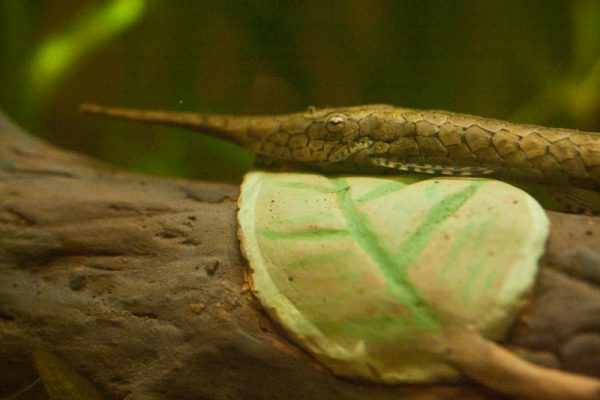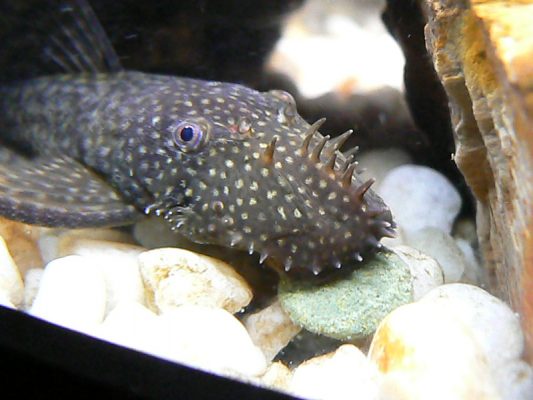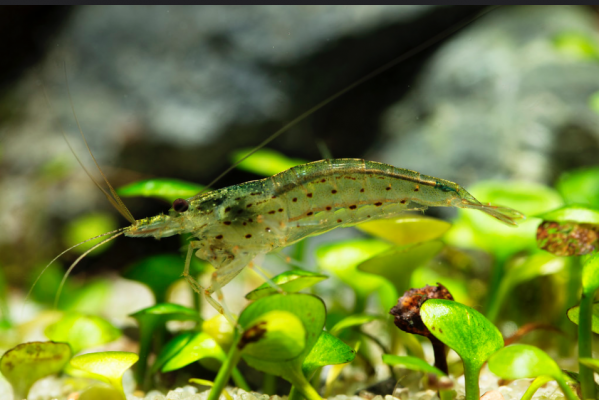Algae is one of the first things to grow in any new aquarium. In a planted aquarium, algae can grow even more rampantly when water parameters are not balanced or lighting and fertilizers are overused. Algae is an expert at taking advantage of rapid water quality changes, excess nutrients, and light. Algae can be maintained or removed by figuring out the cause of the algae growth and giving plants the appropriate amount of care.

 Be sure to dry out your hardscape pieces outside until the algae is completely dead, then scrub them down with hot water.
The next step is to scrub the filter well while also doing several water changes, being sure to gravel vacuum all affected areas. Do not water change over 40 percent as this can shock your livestock. Always be sure to check your water parameters before doing a large water change. Any water added into the tank should always have similar water parameters.
Another way to help reduce black brush algae is to replace any old light bulbs and limiting the lighting periods to no more than 8 hours a day. Small algae tufts that cannot be easily removed by hand can be treated with direct application of small amounts of 3 percent hydrogen peroxide through a pipette. Be sure to turn off all filters and water agitators when treating, and let it sit for 10 minutes before turning filters back on. Never use more than 4 ml peroxide per gallon of aquarium water. A few days after the treatment, the algae will turn pink and then disintegrate. This treatment should be used sparingly. Keeping on top of maintenance and manually removing any algae that pops up should eventually keep the algae from returning, but this could take weeks or months.
Be sure to dry out your hardscape pieces outside until the algae is completely dead, then scrub them down with hot water.
The next step is to scrub the filter well while also doing several water changes, being sure to gravel vacuum all affected areas. Do not water change over 40 percent as this can shock your livestock. Always be sure to check your water parameters before doing a large water change. Any water added into the tank should always have similar water parameters.
Another way to help reduce black brush algae is to replace any old light bulbs and limiting the lighting periods to no more than 8 hours a day. Small algae tufts that cannot be easily removed by hand can be treated with direct application of small amounts of 3 percent hydrogen peroxide through a pipette. Be sure to turn off all filters and water agitators when treating, and let it sit for 10 minutes before turning filters back on. Never use more than 4 ml peroxide per gallon of aquarium water. A few days after the treatment, the algae will turn pink and then disintegrate. This treatment should be used sparingly. Keeping on top of maintenance and manually removing any algae that pops up should eventually keep the algae from returning, but this could take weeks or months.
 Diatom blooms are most commonly seen in newly set-up aquariums where they feed on excess silica from the glass tank. A diatom bloom can also be caused by high levels of waste on leaves and hardscapes. Diatoms are easily removed by wiping them away, and will usually fade away by themselves once the tank is established and plants are growing. As long as wastes are kept under control, they are rarely found in established tanks.
Due to their silica diet, diatoms are not appetizing to many fish. Many small plecos can help manage the blooms, but also leave behind large piles of waste.Bushynose plecos (Ancistrus spp.) and rubberlip plecos (Chaetostoma spp.) are good examples of diatom algae-eaters. Many common aquarium snails, such as nerites, will also eat diatoms, or at least dislodge their coatings as they move around the tank.
Diatom blooms are most commonly seen in newly set-up aquariums where they feed on excess silica from the glass tank. A diatom bloom can also be caused by high levels of waste on leaves and hardscapes. Diatoms are easily removed by wiping them away, and will usually fade away by themselves once the tank is established and plants are growing. As long as wastes are kept under control, they are rarely found in established tanks.
Due to their silica diet, diatoms are not appetizing to many fish. Many small plecos can help manage the blooms, but also leave behind large piles of waste.Bushynose plecos (Ancistrus spp.) and rubberlip plecos (Chaetostoma spp.) are good examples of diatom algae-eaters. Many common aquarium snails, such as nerites, will also eat diatoms, or at least dislodge their coatings as they move around the tank.
Combatting Algae Growth
General conditions that cause algae include a buildup of waste, excessive lighting, and a poor lighting spectrum. Waste buildup can come from livestock, waste, or decaying plant and animal matter. Algae is an opportunistic organism and will easily out-compete other plants in changing conditions. Many people will do very large water changes and deep cleanings when battling an algae outbreak. Although this can help get some algae under control, it can do more harm than good in the long term. Large water changes can actually shock plants and livestock by causing massive swings in the pH and hardness levels in the tank. Deep gravel cleaning can also create ammonia spikes and upset the bacteria balance when the waste is thrown into the water column. It can also disturb the roots of plants. Another method people may use to combat algae spikes is blacking out the lights. Although this may cause algae to recede, it can cause some fast-growing plants to deteriorate very quickly, which adds more waste into the aquarium. It can also keep some plants from recovering as fast, allowing algae to take over while they struggle. The first thing to do when fixing a high-waste or neglected tank is to have the water parameters tested, focusing on nitrates, general hardness, and carbonate hardness. Based on the results of these tests, you can get your levels under control with small, frequent water changes, and adding buffers and salts. Be sure to have your water tested often to be sure everything is recovering smoothly. During these smaller water changes, you can perform a light gravel-vacuuming around non-planted areas of the tank. Be sure to siphon lightly around rocks, driftwood, and other décor, if possible. Running a clean wooden or metal skewer through the gravel is also beneficial as it aerates and removes anaerobic pockets. Manually removing any algae is also highly recommended. After each cleaning, rinsing out your filter with old aquarium water will help remove any debris and wastes that were stirred up by the cleaning.Helping Plants Outcompete Algae
During cleaning, it is also recommended to plant fast-growing plants to help out-compete algae. These plants can be removed once things are back under control. Floating plants are especially good for this and can also provide shade if the plants underneath do not require high lighting. Adjusting your lighting is also important in the prevention of algae growth. If lighting periods are beyond 10 hours a day, lighting should be cut back. Using timers on your lights will ensure that your lighting periods are consistent. The bulbs of the light fixture should also be check or replaced, if needed. The spectrum of old bulbs can shift over time, sometimes giving algae the advantage. Bulbs with high Kelvin ratings or bulbs specifically designed for planted tanks are best. Breaking your light periods into two or more regular blocks is a good way to keep your CO2 levels consistent and will allow you to enjoy your tanks in the morning and evening without leaving your lights on all day. This allows the CO2 that is depleted by the plants during a lights-on period to replenish during a lights-off period. Another way to improve CO2 in your planted aquarium is to dose daily with an aquarium solution that contains glutaraldehyde, which acts as a mild algaecide. Checking to make sure your plants are getting enough macro- and micronutrients to thrive is also an important step in reducing algae. Many aquariums have enough nitrate and phosphate but are lacking in other nutrients such as potassium or iron. Occasional doses of supplements will allow your plants to thrive and reduce algae. If algae issues are especially out of control, over-the-counter algaecides may be useful. This should only be used when you are also treating the cause of the algae issue, or the algae will simply return. Keep in mind that not all algaecides are plant or livestock safe. Be sure to check the product instructions before use.Biological Controls
Many aquarists rely on animals to control algae, such as shrimp. These animals can definitely help control algae, but should not be considered the first line of defense against an algae outbreak. Supplemental food should also be provided to these algae eaters as their algae-grazing alone is not enough to sustain most species.Identifying and Fighting Different Algae Types
An exhaustive list of freshwater algae would take up many books, but this article will go over five of the more common types that appear in planted tanks. There can be multiple factors that lead to an algae outbreak. While some algae are more notorious or appearing when a certain nutrient or factor is out of balance, it may not be the whole story. Always consider each aspect of your aquarium as a whole and how they interact with each other.
Green Spot Algae
Green spot algae is one of the more common types of algae found in planted aquariums. This algae forms green spots usually found on the tank glass. Green spot algae is generally caused by an excess of phosphates and other organics in the system. The best way to take care of this algae is by manually wiping the algae off the glass with an aquarium-safe sponge or razor blade while also treating the cause of the nutrient imbalance. Strong light in one area can make green spot algae outbreaks especially bad. Many snails can be used to combat this algae, but nerite snails are the best for this kind. Small outbreaks can also be managed by oto cats (Otocinclus spp.) and twig catfish (Farlowella spp).Black Brush Algae
Black brush algae can appear as short tufts of dense, soft, black hair on your glass, gravel, hardscapes, or anything else. Black brush algae outbreaks are usually caused by excessive lighting paired with high levels of nitrates, phosphates, and organic matter. This algae can be very difficult to remove once it is established. The best way to get rid of this algae is to begin by removing all affected plants, clumps of gravel, and any hardscape where large tufts are visible. Be sure to dry out your hardscape pieces outside until the algae is completely dead, then scrub them down with hot water.
The next step is to scrub the filter well while also doing several water changes, being sure to gravel vacuum all affected areas. Do not water change over 40 percent as this can shock your livestock. Always be sure to check your water parameters before doing a large water change. Any water added into the tank should always have similar water parameters.
Another way to help reduce black brush algae is to replace any old light bulbs and limiting the lighting periods to no more than 8 hours a day. Small algae tufts that cannot be easily removed by hand can be treated with direct application of small amounts of 3 percent hydrogen peroxide through a pipette. Be sure to turn off all filters and water agitators when treating, and let it sit for 10 minutes before turning filters back on. Never use more than 4 ml peroxide per gallon of aquarium water. A few days after the treatment, the algae will turn pink and then disintegrate. This treatment should be used sparingly. Keeping on top of maintenance and manually removing any algae that pops up should eventually keep the algae from returning, but this could take weeks or months.
Be sure to dry out your hardscape pieces outside until the algae is completely dead, then scrub them down with hot water.
The next step is to scrub the filter well while also doing several water changes, being sure to gravel vacuum all affected areas. Do not water change over 40 percent as this can shock your livestock. Always be sure to check your water parameters before doing a large water change. Any water added into the tank should always have similar water parameters.
Another way to help reduce black brush algae is to replace any old light bulbs and limiting the lighting periods to no more than 8 hours a day. Small algae tufts that cannot be easily removed by hand can be treated with direct application of small amounts of 3 percent hydrogen peroxide through a pipette. Be sure to turn off all filters and water agitators when treating, and let it sit for 10 minutes before turning filters back on. Never use more than 4 ml peroxide per gallon of aquarium water. A few days after the treatment, the algae will turn pink and then disintegrate. This treatment should be used sparingly. Keeping on top of maintenance and manually removing any algae that pops up should eventually keep the algae from returning, but this could take weeks or months.

Read More: Algae Busters: How to Control Algae in Your Aquarium
Blue Green Algae
Blue green algae is not actually an algae, but rather a bacteria called cyanobacteria. This bacteria is able to photosynthesize, allowing it to flourish in comparatively good water conditions. This algae appears as a slimy mat that can appear green, blue, red, or even purple. This algae must be controlled quickly as it can spread rapidly, smothering plants within a few weeks or even days depending on conditions. The first step is to manually remove as much of the algae as possible. This can be done by using a siphon over the mat while stirring, or breaking up, the mat with a plastic or wood skewer. Repeating this process daily will reduce the nitrate levels in the tank. If possible, light should be limited to areas where the algae is growing. Although blue green algae is light sensitive, a blackout may not always work. Adding fast-growing plants and fertilizing these with micronutrients can also help keep blue green algae away as long as the tank is being maintained at healthy and constant nutrient levels. Using lights that have a better spectrum for plant growth can also help your plants outcompete blue green algae for nutrients, and keeping good circulation in your tank will deter it from taking hold. Blue green algae is fairly noxious, and not much will eat it. The animals that do eat it will usually eat plants, too.Green Hair/Thread Algae
Hair and thread algae are common terms used for several species of algae that show up when nitrates, phosphates, and lighting levels are high. Treatment for this algae outbreak is similar to black brush algae. Manual removal of visible algae, regular water changes and filter cleaning, and fixing any nutrient imbalances. Hair and thread algae can grow at a much faster rate than black brush algae. A good algaecide may be useful for large infestations to help stop the spread while treating the source of the problem. The best algae eaters for this kind of algae are various algae-eating shrimp species, especially Amano shrimp. There are several species of fish that will also eat hair and thread algae including American flag fish, dwarf gouramis (Trichogaster lalius), and many livebearers.Brown Algae (Diatoms)
Brown algae is another organism that is not actually an algae, but rather a bloom of photosynthetic organisms called diatoms. These diatoms actually use excess silica to build their exoskeletons. Diatom blooms are most commonly seen in newly set-up aquariums where they feed on excess silica from the glass tank. A diatom bloom can also be caused by high levels of waste on leaves and hardscapes. Diatoms are easily removed by wiping them away, and will usually fade away by themselves once the tank is established and plants are growing. As long as wastes are kept under control, they are rarely found in established tanks.
Due to their silica diet, diatoms are not appetizing to many fish. Many small plecos can help manage the blooms, but also leave behind large piles of waste.Bushynose plecos (Ancistrus spp.) and rubberlip plecos (Chaetostoma spp.) are good examples of diatom algae-eaters. Many common aquarium snails, such as nerites, will also eat diatoms, or at least dislodge their coatings as they move around the tank.
Diatom blooms are most commonly seen in newly set-up aquariums where they feed on excess silica from the glass tank. A diatom bloom can also be caused by high levels of waste on leaves and hardscapes. Diatoms are easily removed by wiping them away, and will usually fade away by themselves once the tank is established and plants are growing. As long as wastes are kept under control, they are rarely found in established tanks.
Due to their silica diet, diatoms are not appetizing to many fish. Many small plecos can help manage the blooms, but also leave behind large piles of waste.Bushynose plecos (Ancistrus spp.) and rubberlip plecos (Chaetostoma spp.) are good examples of diatom algae-eaters. Many common aquarium snails, such as nerites, will also eat diatoms, or at least dislodge their coatings as they move around the tank.

